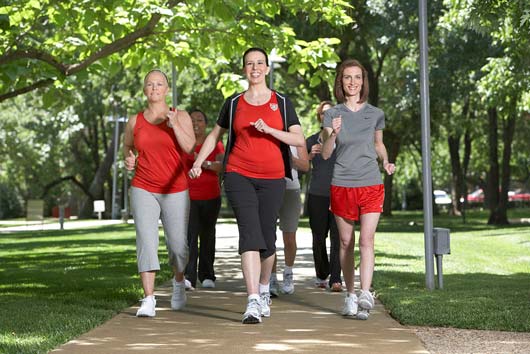
Photo: American Heart Association’s Go Red For Women Movement
I have to admit, as a fitness trainer who specializes in weight loss, I never really considered walking as a plan of attack for my clients. Nevertheless, over recent years I’ve had to take a good, long look at not only the benefits of walking, but the importance of incorporating it into our daily lives. According to the American Heart Association, Americans are spending more time at work than ever before—including more time at computers and desks and less time being active. Physical inactivity has a detrimental effect on your health. But studies show that 30 minutes of daily physical activity can change your life for better and reduce the risk of heart disease, stroke, and other diseases.
Read Related: Fitness After 60: Benefits of Walking
I have found that walking is a great “break-in” exercise. I usually recommend walking to non-physically active individuals as a way to begin with something simple, manageable and, yes, even pleasant. The benefits of brisk walking include weight maintenance, prevention or improvement of health conditions, such as heart disease, and elevated mood, among others. Typically, once these formerly inactive participants experience the benefits of regular walking, they are more apt to upgrade their new exercise routine to a more vigorous level, thus further improving their overall health.
To celebrate the American Heart Association’s National Walking Day on April 2, lace up for your heart and get moving! Make the commitment to start integrating physical activity into your life, whether it’s walking, jogging, going to the gym, or playing sports.
Here are some recommendations on how to begin a walking regimen and integrate it into your daily life:
• First, choose convenient walking routes, such as at a local park. The less of a hassle it is to do, the more likely it is that you will do it. After a while, walking around the same park may become a little dull. Therefore, you may want to explore other walking paths or interesting trails in your neighborhood. There’s a whole world outside your door, but you’ll never see it sitting on your couch!
• Second, remember to take some time to warm up for approximately 5 to 10 minutes, which can include slow walking with long strides and rolling the feet from heel to toe. After you’re all warmed-up, you can increase your speed, shortening your stride and remembering to engage your core (slightly tightening the stomach muscles) while lifting the chest and pulling your shoulders back and down away from your ears.
• Finally, it’s always important to give yourself a good cool-down stretch, which can include toe touches and runners lunges.
In order to stay motivated, why not get the whole crew involved? Have the familia join you on an after-dinner ritual. The kids can even bring their scooters or kick a soccer ball the entire time. This can be a great opportunity to talk about school, friends, etc. At work, invite your co-workers to accompany you during your lunch break. You can even start a company-wide initiative that will not only inspire others, but will keep you accountable as well. After a few weeks (or months) of walking, dare to take it to the next level by picking up the pace and swinging your arms. Later on, you may even want to add light hand weights to the mix to increase intensity and endurance. Remember, it’s all about the long-term effects on your overall health, so keep it fresh, interesting and most of all, consistent. Well what are you waiting for? Grab your sneakers, lace up and get moving toward a healthier heart. Start walking now!
Sign up to participate in the American Heart Association’s National Walking Day and show how you are “lacing up” for your heart and brain health by posting a picture of your red laces in action with the hashtag #AHAlaceup.
María Simón is a fitness trainer and American Heart Association Volunteer Spokesperson. Visit the American Heart Association for more physical activity tips, or follow her at @MariaSimontv, her Facebook page or www.bodybymaria.com.











